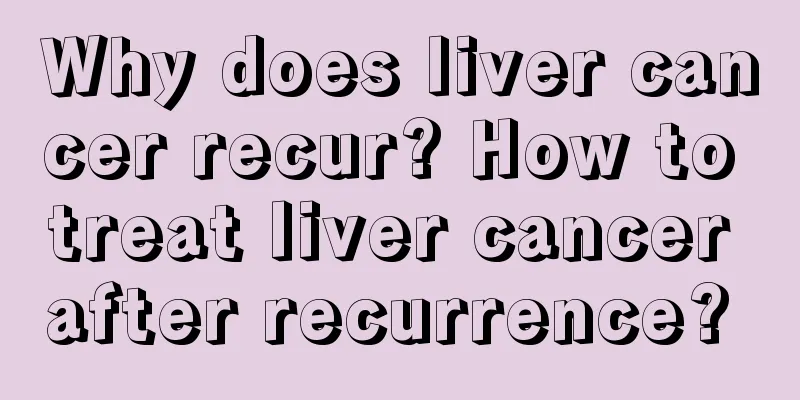Why does liver cancer recur? How to treat liver cancer after recurrence?

|
Once you have liver cancer, you must receive prompt treatment, and surgery is the preferred method for treating liver cancer. However, after liver cancer surgery, most patients will still experience recurrence. Why is liver cancer prone to recurrence? What are the characteristics of recurrent liver cancer? What should we do? Let's take a look! Why does liver cancer recur? What are the characteristics of recurrence? 1. Compared with other tumors, liver cancer has a higher recurrence rate. Generally, the recurrence rate is about 45% three years after surgery, and about 65% five years after surgery. 2. Once liver cancer recurs, there are usually more than one lesion, and the recurrence will occur in multiple locations and liver segments. There are mainly two situations: (1) Before liver cancer resection surgery, the tumor has already invaded other tissues, such as small blood vessels. Therefore, even if the visible tumor is removed, the cancer cells in the small blood vessels will still grow later, leading to recurrence. (2) Some patients have a history of hepatitis B or hepatitis C, and some also have liver cirrhosis. In addition to obvious lumps, these patients also have many tiny lesions that are difficult to detect with the naked eye, which poses a hidden danger for later recurrence. What should I do if liver cancer recurs after surgery? 1. Surgical resection: Surgery can treat recurrent tumors, but because there are often multiple liver cancers after recurrence, it is difficult to remove a large area of the liver or to remove it completely during another surgery. It also damages the patient's vitality, so it is rarely used. 2. Minimally invasive treatment: (1) Hepatic artery chemoembolization (or transcatheter artery embolization) This method involves inserting a tube from the femoral artery of the lower limb or the radial artery of the upper limb to the liver, blocking the artery that supplies the tumor. This will cause ischemia and necrosis of the tumor. At the same time, chemotherapy drugs are infused into the tumor through iodized oil, which can further kill tumor cells without affecting the surrounding normal liver tissue. (2) Chemical ablation: Under the guidance of professional instruments, such as CT, anhydrous alcohol is injected into the tumor lesion to accelerate the rate of cell dehydration and protein coagulation and deformation, thereby destroying cancer cells. This method is a relatively traditional method and is currently rarely used. (3) Physical ablation Including radiofrequency ablation and microwave ablation, which are also carried out under the guidance of B-ultrasound or CT, through the heat generated by the puncture needle to kill tumor cells. 2. Radiotherapy Generally, radiotherapy can be considered as an adjuvant treatment for patients who are unable to undergo surgery or minimally invasive treatment. From the above we can understand the causes and solutions of liver cancer recurrence. Although there are ways to solve the recurrence of liver cancer, the treatment effect is not as good as the first time. Therefore, in order to avoid the recurrence of liver cancer, you must choose a regular hospital during the first treatment and cooperate with the doctor in time and actively. |
Recommend
How to check fibroids in the early stage
In recent years, the research on fibroids has bec...
Can the nose be made smaller?
Nowadays, people have relatively high requirement...
Is Maifan stone pot good?
A medical stone pot is actually a pot that contai...
At what age can a child apply for an ID card?
Nowadays, many parents want to open an exclusive ...
Cholestasis of pregnancy_Symptoms of cholestasis during pregnancy
Cholestasis of pregnancy is a very common gynecol...
What are the advantages and disadvantages of salt water foot soak?
The temperature in winter is relatively low, and ...
Can I eat KFC during confinement?
During the confinement period, you will feel a lo...
Will bone cancer affect having a baby?
According to the current etiology research result...
Bloodletting therapy for acne
In this appearance-oriented society, many people ...
What is dampness and poison
Disease is the most detrimental aspect of life fo...
What are the ways to prevent testicular cancer
Testicular cancer is a common cancer that occurs ...
9 types of angry symptoms that must be taken seriously
From the perspective of traditional Chinese medic...
What causes stabbing pain in the right lower abdomen?
In our daily lives, we often encounter symptoms o...
What's causing the pain in my forehead?
Modern people's health awareness is gradually...
Introduction to the advantages and disadvantages of sweat steaming
Sweat steaming is a leisure and health care metho...









